Students looking for the Bridges in Mathematics Grade 5 Student Book Answer Key Unit 6 Module 3 can find a better approach to solve the problems.
Bridges in Mathematics Grade 5 Student Book Answer Key Unit 6 Module 3
Bridges in Mathematics Grade 5 Student Book Unit 6 Module 3 Session 1 Answer Key
Baseball Box Labels
Brad’s brother, Matt, wants to ship some marbles. He is going to use some of Brad’s baseball boxes. Brad tells him that he can take some partially labeled boxes, if Matt will finish filling in the labels and then give them to Brad so he’ll know which boxes Matt took. None of the boxes have a dimension that is just one ball.
Question 1.
Matt found a box with this label. He could see that one side of the box was 2 balls wide. Complete the label.

Answer:

Question 2.
Brad found a blank label for a box that was twice as tall as the box in problem 1, and had the same size base. Complete the label.

Answer:

Question 3.
Complete the labels for these boxes.
a.

Answer:

b.

Answer:

c.

Answer:

Question 4.
CHALLENGE Matt found a label on the floor that had only the total number of balls, 72. What are three completely different boxes that the label could belong to?
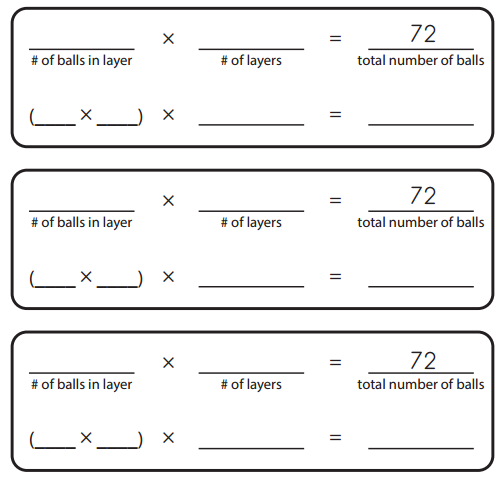
Answer:

Baseballs Packed in Cube-Shaped Boxes
Brad likes to package his baseballs in cube-shaped boxes when he can because they’re easy to pack and ship. The graph to the right shows how many baseballs fit into different sizes of cube shaped boxes. For example, the point at (1, 1) shows that a cube-shaped box that is 1 unit long, 1 unit wide, and 1 unit high holds 1 baseball.
Use the information on the graph to answer these questions.

Question 1.
What does the point (2, 8) represent?
Answer: a cube-shaped boxed with side lengths of two (2 x 2 x 2) holds 8 baseballs because 8 represents (2 x 2 x 2).
Question 2.
What does the point (4, 64) represent?
Answer: A cube-shaped boxed with side lengths of four (4 x 4 x 4) holds 64 baseballs because 64 represents (4 x 4 x 4).
Question 3.
How many balls does a 3 × 3 × 3 box hold?
Answer: 27 balls
3 x 3 x 3 = 27 balls we can also represent this as (3, 27)
Question 4.
Plot the point on the graph that represents how many balls a 3 × 3 × 3 box holds.
Answer:

Question 5.
Steven says that the point (2, 8) is incorrect because 2 × 2 is 4, not 8. Do you agree with Steven? Explain your answer.
Answer: Steven is incorrect.
Explanation: A cube has 3 side lengths-width, length and height and you have to multiply all 3 to get the volume.
2 x 2 x 2 = 8 cubic units.
Bridges in Mathematics Grade 5 Student Book Unit 6 Module 3 Session 2 Answer Key
Packing Matt’s Marbles
Matt is ready to pack his marbles into packing cartons (large boxes) he got from Brad yesterday. The illustrations show the size of an individually boxed baseball and an individually boxed marble, along with one example of a packing carton. How many marbles will fit into each large carton with the dimensions (in units of baseball boxes) below? Show your work.
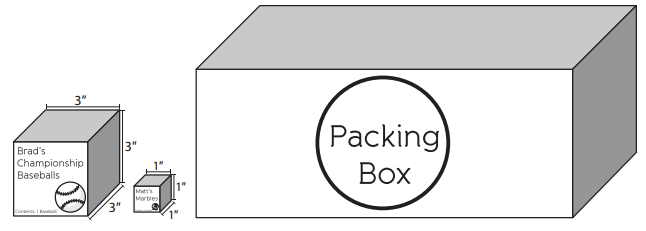
Question 1.
2 × 6 × 6
Answer: 72 balls
2 × 6 × 6 = 12 x 6 = 72 balls
Question 2.
2 × 6 × 12
Answer: 144 balls
2 × 6 × 12 = 12 x 12 = 144 balls
Question 3.
4 × 5 × 3
Answer: 60 balls
4 × 5 × 3 = 20 x 3 = 60 balls
Question 4.
2 × 8 × 3
Answer: 48 balls
2 × 8 × 3 = 16 x 3 = 48 balls
Question 5.
4 baseballs in one layer, with 13 layers
Answer: 52 balls
number of layers = 13
number of layers = 4
number of balls = 13 x 4 = 52 balls
Graphing & Geometry Review
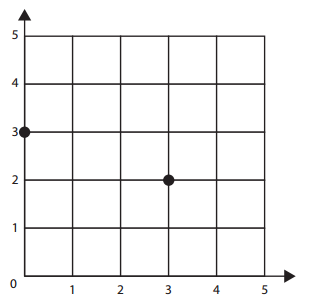
Question 1.
Write the coordinates of the points in the graph. (__________, __________) (__________, __________)
Answer: (0, 3) (3, 2)
Coordinates of the points in the graph (0, 3) (3, 2)
Question 2.
Graph and label these points on the graph: (2, 1), (2, 5), and (1, 4).
Answer:

Question 3.
Connect four of the points on the graph to form one of these figures: rectangle, square, rhombus, or kite. Write the name of the figure you formed, and list 3 of its properties.
Answer:
Rectangle properties:
closed figure, 4 straight sides, 2 pair of parallel sides, 2 right angles
square properties:
closed figure, 4 straight sides, 2 pair of parallel sides, 2 right angles
rhombus properties:
closed figure, 2 pair of parallel sides, four sides congruent
Question 4.
Does a square have all of the properties of a rhombus, or does a rhombus have all of the properties of a square? Use words and labeled sketches to explain.
Answer: yes a square have all the properties of a rhombus because rhombus have 4 sides similar square have 4 sides and both are closed figures with two sides parallel to each other.
Question 5.
How many balls can Brad put in a box that has 6 x 6 balls in the bottom layer and 5 layers? Show your work.
Answer: 180 balls
number of balls that are on the bottom layer = 6 x 6 = 36
number of layers = 5
therefore, total number of balls = 36 x 5
=180 balls
Bridges in Mathematics Grade 5 Student Book Unit 6 Module 3 Session 3 Answer Key
Work Place Instructions 6B Polygon Search
Each pair of players needs:
- 2 Polygon Search Record Sheets
- 2 spinner overlays
- 2 regular pencils, 2 red pencils, and 2 blue pencils
- 2 rulers
- 2 privacy screens (such as folders or books)
Question 1.
Working behind privacy screens, both players spin three times to determine which polygons they will draw on the left coordinate grid, titled “My Board,” on their record sheets.
- Players may draw their polygons anywhere on the board.
- Each shape must have an area of at least 4 square units.
- Each vertex must be placed where the x- and y-coordinates cross.
- Polygons must not touch each other or share any vertices.
Answer:
2 polygon search sheets are provided to both the players. Each player drawn their 3 polygons behind the privacy screens under my board section of record sheet.
Player 1 drawn parallelogram, rectangle and right angle triangle
Player 2 drawn square, rhombus and trapezium.
Both the players drawn in such a way that polygons do not touch each other and their areas are atleast of 4 sq. units.
Question 2.
After both players have drawn their shapes without letting their partner see, players decide who will be Player 1 and who will be Player 2.

Player 1 OK, I’m ready! Are you finished spinning and drawing your three shapes yet?
Answer: After spinning and completing the drawing of 3 polygons, both the players decided and calls for initiation.
Question 3.
Player 1 calls out an ordered pair. Player 2 marks It he ordered pair on his board to see if it falls on any part of one of his polygons, and gives Player 1 one of four responses:
- Hit—if the ordered pair is on a side of a polygon.
- Vertex—if the ordered pair is on a vertex of a polygon.
- Interior—if the ordered pair is inside a polygon.
- Miss—if the ordered pair does not land on or inside a polygon.
Answer:
Player 1 calls out for a coordinate of (4,5)
Question 4.
Player 1 marks the ordered pair on the right coordinate grid, titled “My Partner’s Board,” with:
- A red dot for a hit
- A red “V” for a vertex
- A red “I” for interior
- A blue dot for a miss
Answer:
Player 2 indicate that as vertex, then player 1 mentioned red ‘V’ as it is a vertex.
Question 5.
Players take turns repeating steps 4 and 5, calling and marking ordered pairs in an attempt to locate and correctly identify all three polygons on the partner’s coordinate grid.

Player 2 I want coordinate (6, 7).
Player 1 (Marks his board at (6, 7).) Vertex!
Player 2 Score! I got two of your vertices so far!
Answer:
After calling out coordinates in each turn, player 2 got two vertices of a polygon so far.
Question 6.
When a player believes he can identify one of his partner’s polygons, he must give the most specific name for the polygon and report two of its properties. His partner must tell him whether or not he is correct.

Player 2 I think I know one of your shapes. It’s a parallelogram—see, I’ve got all the vertices marked for one.
Player 1 You’re right, but you have to tell two properties.
Player 2 A parallelogram has 2 pairs of parallel sides, and it’s a quadrilateral.
Answer:
By analyzing the vertices marked, player 2 identified parallelogram as one of the polygon of player 1 and described its 2 features, which is right.
Question 7.
The game ends when one player has located and correctly identified the names and at least two properties for all three polygons her partner constructed on his game board.
Game Variations
A. Players may play for a set time. The player with the most hits wins.
B. Two players may play as a team against another pair.
Answer:
So, the game continues in identifying each polygon of both the players and player 2 wins by identifying and mentioning 2 properties of each polygon correctly.
Finding Volume
Question 1.
Measure the dimensions of the rectangular prisms below in inches. Then find the volume of each prism in cubic inches. Remember to label your answers.
Volume = _______________ Volume = ______________

Answer:
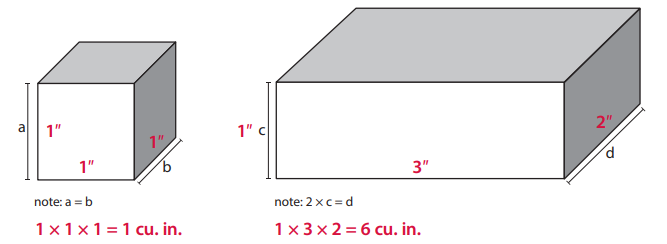
Question 2.
Matt measured the dimensions of a box and found that the area of the base is 16 in2 and the height is 64 in. What is the volume of the box? Show your work.
Answer: 1024 cubic inches
Area of the base = 16 in2
height = 64 in
volume = area * height
volume = 16 x 64
volume = 1024
Question 3.
Matt’s friend, Franny, found that the volume of a rectangular prism was 96 in3. She remembered that the area of the base was 16 in2. What was the height of the box? Show your work.
Answer: 6 inches
height = volume / area
volume = 96 in3
area of the base = 16 in2
height = 96 / 16
height = 6 inches
Bridges in Mathematics Grade 5 Student Book Unit 6 Module 3 Session 4 Answer Key
Volumes Record Sheet
Question 1.
Follow the instructions to find and record the volume of 9 different rectangular prisms.
- Choose a prism.
- Measure its dimensions (length, width, and height) in centimeters, and record them on this sheet.
- Use the formula (length × width × height) to find its volume in cubic centimeters (cm).
- Label all your measurements correctly.

Answer:
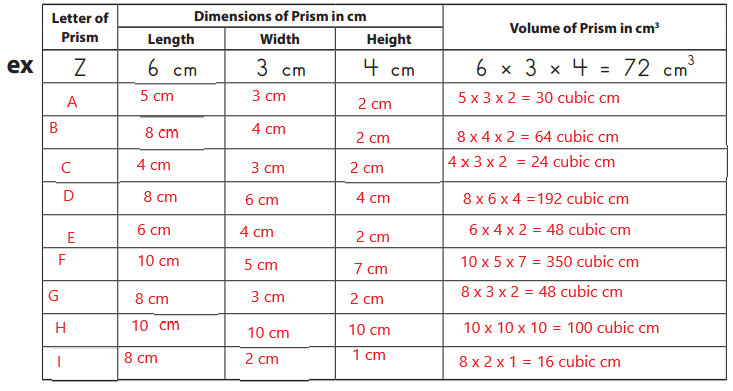
Question 2.
Did any of the prisms you measured have the same volume? If so, which ones? How do the length, width, and height of those prisms compare?
Answer: No all the prisms I measured was not having the same volume. because there height width and lengths are different.
Question 3.
Can you find one prism you measured that has twice the volume of another prism you measured? How do the length, width, and height of those prisms compare?
Answer: No, I cannot find any prism which has the volume twice the volume of another prism.
Tank Volume
Question 1.
At a pet store, the volume of a tank or kennel depends on the size of the pet. Use the information in the pictures to write and solve an equation for the volume of each tank, cage, or kennel. Label your answers with the correct units.
ex:

Equation 20 × 10 × 12 = 2,400
Fish Tank Volume 2,400 in3
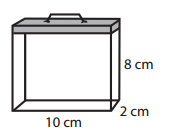
Equation: _____________
Ant Farm Volume: _____________
Answer:

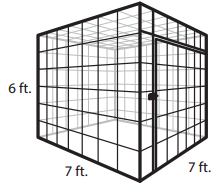
Equation: _____________
Dog Kennel Volume: _____________
Answer:

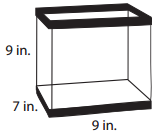
Equation: _____________
Scorpion Tank Volume : _____________
Answer:

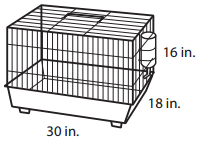
Equation: _____________
Guinea Pig Cage Volume: _____________
Answer:

Bridges in Mathematics Grade 5 Student Book Unit 6 Module 3 Session 5 Answer Key
Work Place Instructions 6C Volume Bingo
Each pair of players needs:
- 2 Volume Bingo Game Boards
- 2 Volume Bingo Record Sheets
- 1 spinner overlay
- game markers (about 20 in each of two different colors)
Question 1.
Players decide who will be Player 1 and who will be Player 2.
Answer:
Both the players are provided with Volume bingo game boards, volume bingo record sheets and a spinner overlay each. They decided who will be the player 1 and player 2.
Question 2.
Player 1 spins twice and records the digits on her record sheet under “Numbers I spun.”
Answer:
Player 1 spins twice and recorded the digits as 4, 3 in her record sheet.
Question 3.
Then, Player 1 thinks of a third factor that will result in a volume listed on her game board when multiplied by the two numbers that she spun.
Answer:
Then she choose number 5 as a third factor to make the volume which is available in bingo game board. Therefore, 4 * 3 * 5 = 60, as it is available in bingo board game.
Question 4.
Player 1 marks the volume chosen on her game board with a game marker, then records the following information on her record sheet: number chosen, volume covered on the game board, and the equation created.

Answer:
she recorded all her values and calculations in the record sheet.
Question 5.
Player 2 checks Player 1’s work and then takes a turn.
Answer:
After checking player 2 work, player 1 takes her turn now.
Question 6.
If a player cannot think of a third factor that makes an uncovered volume on her game board, the turn is lost.
Answer:
Player 2 spins and the two numbers are 4, 5. And, she choose her third number as 2. then the volume becomes 4 * 5* 2= 40.
If there is no scope to choose a third factor, then she can lost her turn.
Question 7.
Players take turns until one player covers five spaces in a row vertically, horizontally, or diagonally.
Game Variations
A. Partners team up to play against another pair.
B. Players play a shorter game where they cover three or four spaces in a row.
C. Players use the Challenge Game Board and spinner for a more difficult game.
Answer:
Player 2 wins the game as she covers five spaces horizontally.
Volume Problems
Question 1.
The volume of a rectangular prism is 140 cubic centimeters. The area of the base of the prism is 20 square centimeters.
- Do you have enough information to find the height of the prism?
- If not, what information do you need? If so, what is the height?

Answer: Yes we have the enough information to find the height of the prism
Question 2.
The base of a rectangular prism is 147 centimeters by 346 centimeters.
- Do you have enough information to find the volume of the prism?
- If not, what information do you need? If so, what is the volume?

Answer: No, we don’t have the enough information to fins the volume of the prism. To find the volume we want the height of the prism.
Question 3.
The volume of a rectangular prism with a square base is 200 cubic centimeters and the height is 8 centimeters.
- Do you have enough information to find the length of the rectangular prism?
- If not, what information do you need? If so, what is the length of the rectangular prism?
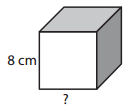
Answer: No we don’t have the enough information to measure the length. we want volume to find the length.
Question 4.
Rectangular prism A has a volume of 38 cm3 and rectangular prism B has a volume of 168 cm3. what is the volume of the figure formed by putting A and B together? Show your work.

Answer: 206 cubic cm
volume = volume of prism A + volume of prism B
volume = 168 + 38 = 206 cubic cm
Question 5.
Miguel says you only need to measure one edge of a cube to find its volume. Do you agree with him? Why or why not? Use numbers, labeled sketches, and words to explain your answer.
Answer: Yes, I will agree with Miguel . Because volume of the cube is length x length x length. So if we know the length we can find the volume.
Question 6.
Mia has already measured the dimensions of this packing box. Help her find the volume. Show your work.

Answer: 192 cubic inches
volume = 8 x 4 x 6 = 192 cubic inches
Question 7.
Brandon is going on a fishing trip with his family. He wants to find the volume of the family’s ice chest. Which expression should he use?

![]() 2 × 3
2 × 3
![]() 3 × 2 × 2
3 × 2 × 2
![]() 3 + 2 + 2
3 + 2 + 2
![]() (3 × 2) – 2
(3 × 2) – 2
Answer: 3 × 2 × 2
volume = length x width x height
volume = 3 x 2 x 2
Question 8.
Jeff’ s little brother is trying to find out how many alphabet blocks will fit into a shoebox. He is measuring:

![]() the volume of the shoebox
the volume of the shoebox
![]() the area of the shoebox
the area of the shoebox
![]() the length of the shoebox
the length of the shoebox
Answer: the volume of the shoebox
Because volume defines the amount that will fit.
Question 9.
Which of these situations is about volume?
![]() determining the amount of fencing it takes to go around a square garden
determining the amount of fencing it takes to go around a square garden
![]() determining how many tiles it will take to cover the kitchen floor
determining how many tiles it will take to cover the kitchen floor
![]() determining how many rectangular containers of food will fit into a freezer
determining how many rectangular containers of food will fit into a freezer
Answer: determining how many rectangular containers of food will fit into a freezer
Because volume defines the amount that will fit.
Question 10.
Vanesa wants to find the volume of her lunchbox. Which of these units should she use?
![]() cubic feet
cubic feet
![]() cubic inches
cubic inches
![]() cubic yards
cubic yards
Answer: cubic inches
because lunchbox usually measures in inches or cm.
Question 11.
The volume of this rectangular solid is 40 cubic feet. What is its height? Show your work.

Answer: height = 4 feet
volume = 40 cubic feet
volume = height x length x width
therefore, volume = 40 cubic feet
Question 12.
CHALLENGE The volume of this cube is 216 cubic inches. What is the length of each edge? Show your work.

Answer: length = 6 inches
given, volume = 216 cubic inches
length = ?
length = 6 inches
Pet Snacks
Question 1.
The pet store sells boxes of pet food and snacks in four sizes. Write and solve an equation to find the volume of each box. Label your answers with the correct units.
a.
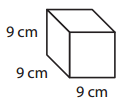
Equation
Volume
Answer:

b.

Equation
Volume
Answer:

c.
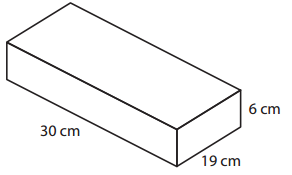
Equation
Volume
Answer:

d.
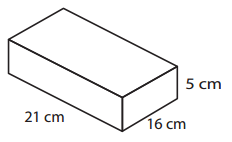
Equation
Volume
Answer:

Question 2.
Use the information above to solve these problems.
a. How much more is the volume of box c than the volume of box a? Show your work.
Answer: 2691 cubic cm
volume of box c = 3420
volume of box a = 729
more volume box c than volume of box a = 3420 – 729
b. What is the combined volume of boxes b and d? Show your work.
Answer: 2139 cubic cm
combined volume of boxes b and d = 459 + 1680
c. Jenny bought 3 boxes of Yummy Dog Snacks, the same size as shown in d above. What is the total volume of the 3 boxes put together? Show your work.
Answer: 5040 cubic cm
volume of box d = 1680 cubic cm
number of boxes = 3
Therefore, total number of boxes put together = 1680 x 3
= 5040